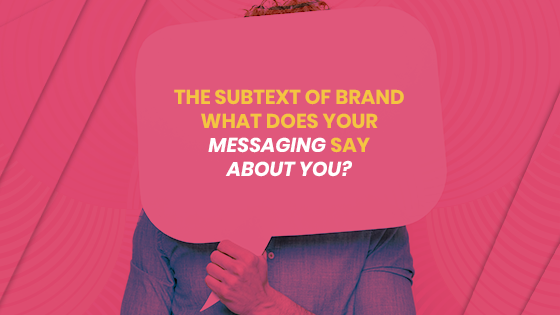


The subtext of brand - what does your messaging say about you?




Marketers are hard to control. We want to do things 'our way'. We hate edits. We hate vague feedback.
I'm not bitching, I'm a marketer! It's the way we marketing folk are made; our inherent nature is to please, it's why we're in marketing; to delight people. If it wasn't we'd be accountants or bankers.
We see those pesky red, underlined comments and tracked changes, our inner voice screams "you're wrong!". But maybe by taking a little time to understand why it's not right and why it wasn't right the first time, could save us all time in the long run? You never know, it could help our fragile egos as well, or perhaps just mine?!
With brands communicating across various mediums, a proliferation of platforms that seems to gather more and more momentum every year, each bringing a new character count, new 'etiquettes' and norms, new languages, and new communication methods, how are we ever to ensure our brand is consistent across each platform; simultaneously meeting the needs of the users without diluting or muddying our brand's personality?
The answer could lie in creating a brand message architecture. A strategy that allows marketing and content teams (and perhaps across the wider organisation) to encapsulate what your brand should sound and feel like, without forcing teams to use key phrases or shoehorned messages that sound more robotic than Microsoft Sam of the early 2000s.
What is a brand message architecture?
"It's a North Star that everyone on a project (internal and external) can work toward."
Content Marketing Institute
A brand message architecture can be as simple as a list of words that helps direct your team when producing communication across all platforms and channels. Words that encapsulate what your brand is about, in a hierarchical structure of priority, allowing teams to understand how they should be communicating and how far they can push the boundaries.
It isn't your brand identity or your content strategy.
Nor is it your mission statement.
It isn't copy either; it's messaging.
Therefore it should be one layer beneath the surface, be inferred but not used, only seeing the light of day if all other words have been exhausted and your brand's survival demands it. Really.
You will have felt 'big brands' doing it, but won't have noticed it. The difference is that when you feel it, you consider the brand to be authentic as if everyone is 'in sync'. Every interaction feels genuine, regardless of platform or person. And then there's time you'll notice it (which is bad).
Politicians are an easy target, especially at the moment. They're given a list of messaging and phrases to communicate and they use it verbatim rather than understanding what the actual message is and wrapping it in their own context. They're the ones who read 'integrity' and shoehorn it into every sentence and shout it from the Houses of Parliament's rooftops.
Is now the right time?
Many organisations feel that they're 'not big enough' to need to invest the time into encapsulating what their brand message architecture is. But the smaller the organisation, the easier it is to do.
By taking the time at the birth of a brand it allows the tone to be set from day one, rather than trying to retrospectively fit what three content marketers, four freelancers, and an outsourced agency already said about your brand.
It allows your team to stay aligned.
Your content to stay consistent.
And your brand, authentic.
As the usual surroundings of the office disappeared amidst COVID, the chances to 'throw it around the room' faded with it. There is also a growing market to outsource aspects of content marketing to experts more well-versed in the requirements of the platforms and the audiences that spend their time there.
But by choosing technical expertise over context you're potentially losing the identity of your brand and the true personality of the organisation unless you've clearly articulated your brand message architecture.
Whether it's Scott the Social Media Scripter, Freddie the Freelance Blog Writer, or Claire the Collateral Crafter, they all need to be on the same page.
The clarity will be appreciated by all; your team will finally know what you want, your organisation will feel the cohesion of your comms and your red pen will be thankful for a break.
Customers are using the pounds in their pockets to get their voices heard, choosing to spend money with brands who reflect who they are as people, and authenticity plays a big part.
COVID has put brands under the spotlight more than ever, brands that meet the audience with authentic, relevant communications will be remembered long after lockdown. There's never been a more important time to create a brand message architecture.







